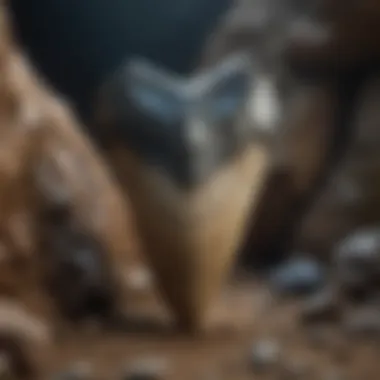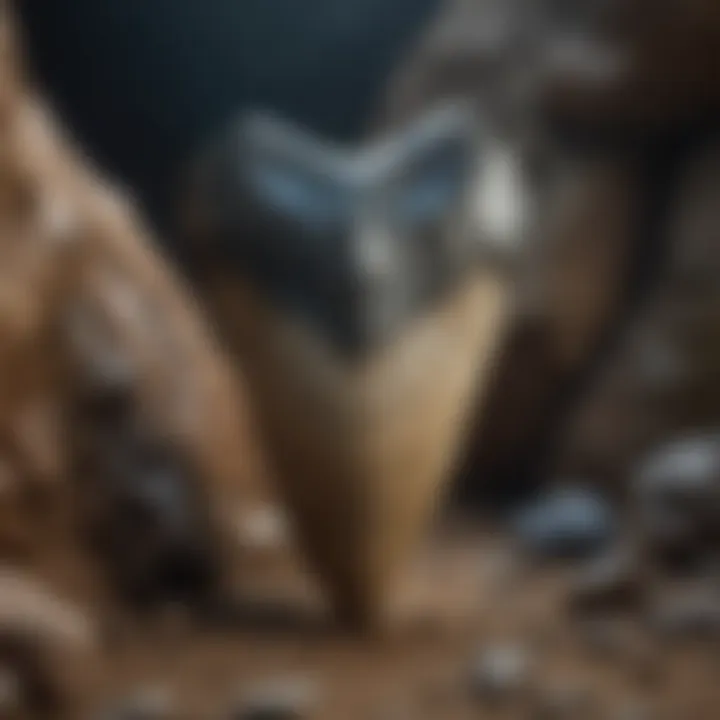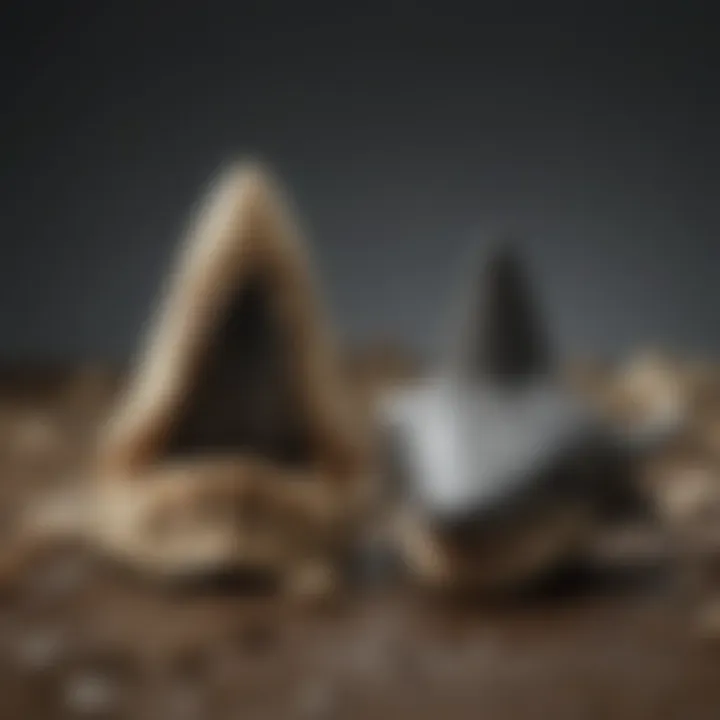Megalodon Tooth Insights: A Collector's Guide


Intro
The megalodon tooth, a striking emblem of the ocean's prehistoric giants, captures the imagination of enthusiasts and collectors alike. These fossilized remnants represent not just a glimpse into ancient marine life but also a testament to nature’s power and ferocity. As one grapples with the enormity of these creatures, the teeth emerge as tangible connections to an era long past. This guide endeavors to illuminate the complexities surrounding the megalodon tooth, ranging from its historical significance to practical advice for collectors.
Understanding the journey of a megalodon tooth extends beyond mere acquisition; it invites a deeper appreciation of history, geology, and conservation. The tale unfolds in two decisive arenas: the excitement that comes with collecting and the responsibility that accompanies the preservation of such natural artifacts. Each tooth carries with it a narrative – a story crafted over millions of years through geological changes and biological evolution.
Through this exploration, both seasoned collectors and curious newcomers will find valuable insights into identifying these remarkable artifacts, the thrill of the hunt, and the love of preserving pieces of our planet’s rich history.
Featured Collectible of the Month
Overview
This month, we shine a spotlight on a particularly fascinating specimen: a megalodon tooth unearthed in South Carolina, a region that has earned a reputation as a treasure trove for fossil enthusiasts. This certain tooth, measuring nearly seven inches long, exhibits stunning serration still intact, a sign of its age and the violent history it once belonged to. Highlighting such collectables serves to kindle a greater interest in the hobby, while reminding collectors of the thrill of discovery.
Historical Significance
Megalodon, scientifically known as Carcharocles megalodon, swam the oceans from approximately 23 to 3.6 million years ago. The fascination with this creature stems from its sheer size—estimates suggest it could reach lengths of up to 60 feet. The impact of megalodon on marine ecosystems was profound, making it an apex predator of its time.
Through their formidable teeth, collectors gain access to a window into the ecological dynamics of prehistoric seas. Each tooth uncovered contributes to our understanding of the megalodon’s diet, behavior, and even its eventual extinction.
Collectors often find joy in pondering: What ocean currents did this tooth travel through? What prey did it consume while it patrolled its watery domain? These questions not only enhance the appreciation of the tooth but also encourage deeper research into the broader geological and biological contexts.
"Each megalodon tooth tells a story, connecting the past to the present in ways that few other artifacts can."
Identification Techniques
Visual Characteristics
Identifying a megalodon tooth involves careful analysis of several key visual traits. Here are some characteristics that can help collectors get started:
- Size and Shape: Megalodon teeth are notably larger than those of any modern shark. A typical tooth is triangular, featuring broad, serrated edges.
- Serration Patterns: The teeth often exhibit distinct serrations, which were key to their hunting capabilities. Examining the number and depth of serrations can aid in identification.
- Color Variations: Ranging from gray to black, the color of a megalodon tooth can vary based on its preservation conditions and the sediment it was buried in.
- Root Structure: A well-preserved root is a must-see to distinguish genuine teeth from replicas. Actual fossils will often have a slightly curved root, a feature typical to the species.
Resources for Identification
For collectors seeking deeper knowledge, several resources can be invaluable:
- Online forums such as Reddit provide vibrant discussions and insights from seasoned collectors.
- The Wikipedia page on megalodon offers a broad understanding of its classification and historical context. Visit Wikipedia: Megalodon.
- Facebook groups dedicated to fossil collectors serve as great platforms for sharing information and tips on identification.
- Additional comprehensive descriptions can also be found on Britannica.
Arming oneself with knowledge vastly enhances the collecting experience. Understanding how to spot and appreciate the nuances of megalodon teeth not only enhances a collection but also deepens the connection to the fascinating world of paleontology.
Intro to Megalodon
Understanding the megalodon isn’t just a passing interest in marine biology; it’s a gateway into the deeper history of our planet's oceans. This section lays the groundwork for appreciating the sheer magnitude and significance of this ancient predator. By grasping its basics, collectors can enrich their quest for megalodon teeth, knowing what they represent. It's not merely about the size of these teeth, but what they symbolize—the bustling ecosystems of the oceans millions of years ago and the evolution of apex predators.
The Megalodon: An Overview
The megalodon, scientifically known as Carcharocles megalodon, is often hailed as the largest shark to roam the Earth, with estimates suggesting it could reach lengths of over 60 feet. Imagine something bigger than a school bus lurking in the waters! The size of this beast is astounding, but it’s not just dimensions that captivate collectors.
This formidable creature lived during the Cenozoic era, roughly 23 to 3.6 million years ago. Its sheer dominance over prehistoric marine life has left an indelible mark on both popular culture and scientific study. It’s crucial for collectors to understand the evolutionary context of the megalodon to appreciate the teeth they seek—these relics are not just fossilized remains; they are tangible links to a time when the oceans were ruled by this gigantic predator.
The Fossil Record
The fossil record of the megalodon is both extensive and enlightening. With teeth being the primary source of megalodon fossils, collectors should take note of their unique characteristics. Unlike bones, shark teeth are made of dentin and enamel, making them more prone to preservation in sediment. The rugged, serrated edges of the teeth—which can measure over seven inches—are key identifiers of this creature.


- Geological Significance: The distribution of megalodon teeth across various sedimentary layers around the world reveals much about ancient marine environments and their transformations over millions of years.
- Location Details: Some prime locations for finding these teeth include coastal areas rich in marine sediments, such as the beaches of South Carolina and the tributaries of the Chesapeake Bay.
"The fossil record does not merely tell us about the megalodon’s existence; it also illuminates the changing tides of Earth's history, serving as a reminder of nature's ever-evolving choreography."
Collectors venturing into this field must integrate this context into their collecting journey. Knowledge isn’t just power; it’s the difference between a mere collection and a curatorial history rich in narrative.
Understanding Megalodon Teeth
Megalodon teeth are more than just ancient artifacts; they serve as vital clues to understanding a creature that once ruled the oceans. For collectors, knowing the significance of these fossils can enhance both their hobby and their appreciation of marine history. Each tooth carries a story not only of the animal itself, but also of the geological conditions that allowed it to exist. This section digs into the nuances of megalodon teeth, encompassing their anatomical features and the various shapes and sizes these remarkable fossils can take.
Anatomy of the Tooth
The anatomy of a megalodon tooth is a fascinating study in evolution and adaptation. These teeth, which can measure over seven inches in length, exhibit distinct characteristics that set them apart from those of modern sharks.
- Shape: Megalodon teeth have a broad, triangular shape with serrated edges, perfect for slicing through flesh and bone. The design is not accidental; it speaks volumes about their predatory lifestyle.
- Root Structure: The root of the tooth is substantial and curved, essential for anchoring the massive tooth into the jaw. The configuration varies depending on the position of the tooth within the jaw—those at the front are typically larger and more triangular, while the ones further back display a flatter profile.
- Material Composition: Megalodon teeth, like those of other sharks, are made of dentin and enamel, though the mineralization level can vary. This accounts for durability, but also means that finding an intact specimen can be a challenge.
Understanding these anatomical features becomes important when assessing the value and authenticity of a tooth. Collectors must be vigilant about distinguishing genuine fossils from replicas or lower-quality finds. Knowing what to look for can save time and resources in the long run.
Variations in Tooth Size and Shape
The variations in megalodon tooth size and shape are not just trivial; they reflect the diverse feeding habits and ecological niches occupied by these predators millions of years ago.
- Front Teeth vs. Back Teeth: Front teeth tend to be larger and are adapted for grasping and holding, while back teeth are designed for grinding. Collectors will often seek out front teeth for their impressive size and aesthetic appeal.
- Regional Differences: Geographic factors also play a role in variation. Fossils from the Atlantic may differ in shape and size compared to those from the Pacific due to ecological differences in the prehistoric environments.
- Individual Variation: Just like modern animals, individual megalodons could experience variations caused by age, diet, and even health conditions. This variability adds depth to each specimen and can be a talking point among collectors.
"Every megalodon tooth is like a snapshot in time, telling us not just about the animal it belonged to, but the world it swam in."
In summary, understanding the anatomy and variations of megalodon teeth can empower collectors. By equipping themselves with knowledge, they can distinctly identify authentic fossils while appreciating the broader story that each tooth represents. This detailed insight builds a bridge between the collector and the fascinating history surrounding these colossal predators.
The Geology of Megalodon Fossils
Understanding the geology surrounding megalodon fossils is crucial for both collectors and enthusiasts alike. This knowledge allows one to appreciate not just the beauty of these ancient teeth, but also the larger narrative of Earth's history and climate changes. The study of geology provides essential context that can deepen the collector's experience, connecting each fossil to the environment it originated from, thus enhancing its value from both a scientific and a sentimental perspective.
Fossilization Processes
Fossilization is a complex affair, turning organic remains into preserved relics of the past. The megalodon, a colossal predator that once ruled the ancient seas, left behind an array of teeth that continue to excite the imagination. Understanding how these teeth became fossils involves several key processes:
- Burial: After the megalodon would lose or shed a tooth, it often sank to the ocean floor. If the conditions were right, sediment would cover the tooth. This burial protects it from most types of decay or destruction.
- Mineralization: Over long periods, the organic materials in the tooth can be replaced by minerals (like silica or calcite). This is a slow, transformative process that can result in stunningly beautiful specimens.
- Erosion and Exposure: The surrounding sediment may eventually erode away, exposing the ancient teeth. Factors like water currents and environmental changes play significant roles here. Understanding this cycle helps collectors appreciate the rarity of condition when they find a well-preserved megalodon tooth.
The fossilization process is not merely a technical detail; it tells a story of survival, environment, and geologic conditions. By grasping these processes, collectors can also expect to gain a sense of timing about when and where these fossils indicate historical conditions on Earth.
Prime Locations for Finding Teeth
Finding megalodon teeth is no small feat. But, if you're keen on becoming a successful collector, it's vital to know where to look. A few prime locations have become somewhat legends in the collecting community:
- South Carolina's Edisto River: Known for its rich deposits, collectors flock here to sift through the waters, especially during low tide when many teeth can be seen.
- Florida’s Venice Beach: Often referred to as the "Shark Tooth Capital of the World," this beachfront offers easy access for those eager to search the sands.
- North Carolina: Various sites along the coast, particularly around the Cape Hatteras area, provide excellent opportunities for discovery.
- Maryland: The Calvert Cliffs along the Chesapeake Bay are known for the fossilized remains of many marine species, including megalodon teeth, making it a hotspot for fossil hunting enthusiasts.
It's essential to abide by local regulations and obtain the necessary permissions where required. Collecting fossilized teeth can be thrilling, but it's also important to maintain respect for nature and heritage as well the vibrant communities that surround these rich geological locations.
"The thrill of finding a megalodon tooth isn’t just in the prize itself, but in the history and geology that comes with it. Each tooth connects you to a time when these monsters ruled the oceans, and understanding that context only enhances the find."
Collecting Megalodon Teeth
Collecting megalodon teeth is not just a hobby; it's a doorway into the vast wonders of our planet's prehistoric past. For many enthusiasts, it represents a tangible link to a time when these colossal sharks roamed the oceans, evoking a sense of awe and curiosity. This practice encompasses a range of aspects that elevate it beyond mere collection. The thrill of the hunt, the stories tied to each tooth, and the scientific significance of these fossils all combine to create an engaging experience.


Engaging in this collecting endeavor brings forth several benefits. Firstly, finding a megalodon tooth can be incredibly rewarding. Each piece tells a story, bridging the gap between ancient marine life and today’s world, allowing collectors to act as custodians of history. Not to mention, it often leads to a deeper understanding of marine biology and earth's geological history.
Moreover, the realm of megalodon tooth collection encourages social interaction amongst enthusiasts. Whether through local clubs, online forums like those found on reddit.com, or fossil shows, collectors have the chance to share their passion and discoveries. There’s a sense of community built around shared interests, knowledge, and excitement.
However, collecting megalodon teeth also necessitates some practical considerations. From ensuring the authenticity of teeth to being aware of local laws regarding fossil collection, a thoughtful approach can prevent missteps that could dampen the joy of collecting. This article delves into essential tips, advanced strategies, and methods for assessing quality and authenticity, ensuring collectors embark on their journey well-prepared.
Tips for New Collectors
Starting out can feel daunting, yet with the right approach, new collectors can quickly find their footing. Here are some foundational tips to guide you:
- Start Small: Begin with locating smaller teeth or less expensive pieces. This allows for a hands-on learning experience without a significant financial commitment.
- Research Locations: Identify local beaches or riverbeds known for fossil finds. For instance, Shark Tooth Beach in Florida has garnered attention for its abundant megalodon teeth.
- Educate Yourself: Before diving into buying or collecting, take the time to learn about the different types of megalodon teeth, their shapes, and sizes. Knowledge is your most valuable tool.
- Network: Engaging with experienced collectors at forums or local fossil fairs can reveal insights and tips that save you time and effort.
These initial steps not only establish a foundation for a solid collection but also create an exhilarating start into the world of megalodon teeth.
Advanced Collecting Strategies
Once you’ve grasped the basics, it’s time to elevate your collecting game. Here are some advanced strategies for seasoned enthusiasts:
- Specialize in Regions: Focus on specific geographical areas that are known for unique or rare megalodon finds. For instance, certain areas in South Carolina are prized for their larger specimens.
- Invest in Quality: Look beyond sheer size or quantity; prioritize the quality and uniqueness of each piece. A well-preserved tooth can appreciate in value over time.
- Join Specialized Associations: Consider memberships in fossil hunting organizations that provide access to exclusive events, expert-led sessions, and networking opportunities.
- Understand Market Dynamics: Keeping track of trends in the fossil market can assist in making informed decisions regarding purchasing and selling pieces.
Utilizing these strategies can enhance both your experience and the potential value of your collection.
Assessing Quality and Authenticity
As the community of collectors grows, so does the presence of fraudulent pieces. Avoid falling into the trap of acquiring inauthentic teeth by sharpening your assessment skills. Here are key points to consider:
- Examine Craftsmanship: Check for signs of wear, natural imperfections, and growth lines. Authentically sourced fossils will have a level of irregularity that distinguishes them from artificial replicas.
- Seek Expert Opinions: When in doubt, consult with experts or appraisers who specialize in fossils. Their expertise can ensure you're making sound investments.
- Consider Provenance: Understanding the background and history of a tooth can provide insights into its authenticity and value. Always request information regarding the source when buying.
- Document Findings: Keeping a record of where and when you found each tooth can add value by establishing its provenance.
In summary, the world of collecting megalodon teeth is layered with history, community, and the thrill of discovery. Whether you’re just starting or looking to enhance your expertise, these insights provide the framework for a rewarding journey into this fascinating pursuit.
Care and Preservation of Megalodon Teeth
Taking good care of your megalodon teeth is vital for maintaining both their aesthetic appeal and historical value. As invaluable remnants of Earth's prehistoric past, these fossils can become cherished pieces in any collection. Proper care ensures not just their physical integrity but also their long-term appreciation among collectors and enthusiasts alike. Implementing simple yet effective preservation strategies can make a significant difference in how these remarkable artifacts age.
Cleaning Techniques
Cleaning megalodon teeth requires a bit of finesse. It's essential to be gentle to avoid damaging the delicate surfaces which can tell you volumes about their history.
- Brushing with Care: A soft-bristled toothbrush works wonders. Why? Well, it's great at removing debris without being too abrasive. A light touch is the key. Avoid using hard brushes that might scratch or degrade the tooth's surface.
- Natural Solutions: Sometimes a mix of mild soap with warm water is all you need. Use a cloth or sponge to gently clean the tooth, ensuring that you avoid soaking it – too much moisture can lead to deterioration.
- Avoid Harsh Chemicals: Using bleach or other harsh cleaners is a no-go. They can strip away not only the dirt but also the natural qualities of the fossil. All the beauty of the tooth's texture and coloration can be lost.
- Drying Properly: After cleaning, it's important to air dry the teeth instead of rubbing them with a cloth. Rubbing can cause scratches that mar their appearance.
By following these cleaning tips, collectors can prevent the gradual wear and tear that often plagues improperly cared-for fossils.
Optimal Display Options
How you display your megalodon teeth can greatly impact their preservation and your enjoyment of them. A well-thought-out display not only showcases these fossils but also protects them from unnecessary wear.
- Shadow Boxes: These are an excellent way to present your specimens while keeping them safe from dust and handling. Using a shadow box gives depth as well, making the tooth pop against a darker backdrop.
- UV-Protective Glass: If you opt for display cases, using glass that blocks UV light is essential. UV rays can fade colors and degrade materials over time. A simple glass case can prevent a lot of wear on the teeth.
- Secure Mounting: Consider using padded stands or mounts that hold the tooth securely without damaging it. Being cautious with weight distribution might help avoid any potential chips or cracks.
- Away from Sunlight: Keeping your collection out of direct sunlight is crucial. Sunlight can warp and crack teeth, especially if they've been cleaned or polished recently.
"The attention you give to preserving your specimens reflects directly in their beauty and longevity."
Whether you are a novice or an experienced collector, these practices will help preserve your treasures and showcase them in the manner they deserve.
Historical and Cultural Significance


The megalodon, a prehistoric giant shark that swam the oceans millions of years ago, holds a fascination that transcends mere paleontological interest. Its teeth, particularly, carry both historical and cultural weight that has drawn attention from various fields, including science, art, and folklore. As collectors pursue these relics of the ancient past, it becomes essential to understand the significance that megalodon teeth carry in these contexts.
Megalodon in Popular Culture
The megalodon has been a mainstay in popular culture, often portrayed in films and literature as a colossal predator lurking in the depths of the ocean. Movies such as "The Meg" or documentaries on sharks introduce audiences to the idea of this formidable creature, sparking intrigue and fear alike. Its depiction in media often emphasizes the sheer size and ferocity of the megalodon, drawing parallels with modern-day sharks but amplifying the terror. This cultural representation serves not only to entertain but also to educate about marine life evolution and the geological epochs during which such creatures existed.
- Key Elements in Popular Culture:
- Movies and documentaries that reinforce its fearsome reputation.
- Numerous books that blend fact and fiction, capturing the imagination of readers.
- The formation of enthusiasts' groups and forums, with platforms like Reddit and Facebook fostering discussions on megalodon lore.
Additionally, megalodon teeth have become popular collectibles, often used as unique decorations or conversation starters. Collectors might find that these artifacts have grown in stature, not merely as scientific specimens, but as cultural icons, representing a connection to the Earth’s history and a reminder of nature’s magnificence.
Scientific Research and Discoveries
In the realm of scientific inquiry, the megalodon has caused considerable excitement. Paleontologists utilize megalodon teeth to unlock insights into the evolutionary forces that shaped marine ecosystems. The distinct morphology of these teeth has allowed researchers to hypothesize about the megalodon’s diet, behavior, and its environment millions of years ago.
Through the analysis of fossilized teeth, scientists have made strides in understanding:
- The size estimates of the megalodon, as teeth are often the only remaining evidence of this creature.
- Insights into its predatory role and how it interacted in marine food webs.
- The geographical distribution and habitats these sharks occupied.
“Megalodon teeth are windows to a lost world, helping us comprehend the dynamics of ancient oceans.”
This deep dive into scientific research highlights more than curiosity; it informs conservation efforts for existing shark species. Understanding the past can give insights into current environmental challenges, showing how long-term changes affect marine life.
Rarity and Market Value of Megalodon Teeth
Megalodon teeth, with their striking size and unique characteristics, have become highly sought-after items among collectors and enthusiasts. The rarity and market value of these fossils play a significant role in the collecting landscape. Understanding these factors not only enriches the collecting experience but also provides insights into the ongoing fascination with the ancient past. Whether you are an aspiring collector or a seasoned enthusiast, knowing how rarity and value interplay can sharpen your instincts and guide your purchases.
Factors Influencing Rarity
Several elements contribute to the rarity of megalodon teeth, and these can dramatically influence both their desirability and price. Here are key factors to keep in mind:
- Condition: The state of the tooth is paramount. Teeth that have well-preserved enamel and fewer abrasions fetch higher prices. Teeth with little or no damage are almost like gold in the eyes of collectors.
- Size: Larger specimens are typically rarer than smaller ones. An undamaged, sizable megalodon tooth can be a centerpiece in any collection, boasting value that escalates with size.
- Location of Find: Teeth found in locations known for their fossil richness and geological significance might carry a premium. For example, Florida's Shark Tooth Coast is renowned. Collectors often desire teeth from these famed locations, adding to their rarity.
- Age and Authenticity: Older teeth that are verified through provenance add to their rarity. Fossils that have undergone extensive scientific study can command higher prices due to verified age and authenticity.
- Historical Significance: Teeth with documented histories or those associated with important scientific discoveries can also be deemed rare. If a tooth has special historical ties, it can rise in value significantly.
"The caution stops here—knowing what makes a megalodon tooth rare is your functional compass in navigating this intriguing market."
Understanding Market Trends
The market for megalodon teeth is ever-evolving, influenced by various trends that come and go like the tides of the ocean. Here are some factors shaping the current landscape:
- Collector Demand: As more people dive into the art of collecting, the demand for megalodon teeth has surged. Online auction sites and fossil shows flourish with eager bidders. The more people who want a piece of the action, the rarer and pricer these teeth could become.
- Quality vs. Price: There’s a constant tug-of-war between quality and what collectors are willing to pay. A high-quality tooth might hold more value in the long run, yet budget-conscious collectors sometimes overlook this, leading to a diverse market with various options.
- Emerging Patterns: Trends tend to shift based on popular culture, scientific findings, or even social media showcases. The rise of influencers who delve into scientific explanations or fossil presentations can spike interest quickly.
- Increased Awareness: As educational resources become widely accessible, there's a growing appreciation for the science surrounding these ancient wonders. This awareness elevates the market value, pushing collectors to acknowledge not just the aesthetic but the story behind the tooth.
- Regulations and Conservation Efforts: Local laws regarding fossil collecting can impact availability and therefore price. Regions that tighten their regulations can lead to lower supply, increasing value for those who can legally procure them.
Megalodon teeth are not just relics of a bygone era; they are a commentary on our current trends and societal interests. As collectors navigate through a nuanced market, understanding the factors that drive rarity and market value will provide clarity and enhance the enjoyment of this captivating pursuit.
The End
In closing, the profound allure of megalodon teeth resonates with both the hobby of collecting and the broader scientific community. This article has intricately woven together various aspects of these ancient relics, shedding light on their historical significance, geological circumstances, and the thrill of discovery. Each tooth encapsulates a story, echoing the majesty and mystery of a predator that once roamed the oceans, prompting a fascination that transcends time.
The Ongoing Fascination with Megalodon Teeth
It’s no wonder people are hooked on collecting megalodon teeth. Beyond their impressive size, these fossils articulate a history that sparks curiosity about prehistoric marine life. The mystery surrounding the megalodon continues to intrigue, with documentaries and films reviving interest in its legacy. Collectors often find themselves part of this narrative, holding a piece of Earth's history in their hands and connecting with a past that informs the present.
From museums showcasing colossal specimens to local fairs featuring small vendors, megalodon teeth attract a diverse audience. As collectors dive deeper into this pursuit, they often stumble upon rich communities that thrive on shared knowledge and camaraderie.
"Every tooth tells a tale, with each dentition representing an encounter in the expansive realm of ancient oceans."
This journey of collecting is not merely about possession, but also about understanding and preserving the fragility of both the remains and the ecosystems that have changed over millions of years. Maintaining awareness of ethical collecting practices ensures that these fascinating pieces of history are not lost in the sands of time.
Ultimately, the megalodon tooth serves as more than a collector's artifact. It stands as a testament to our planet's natural wonders and the stories waiting to be unearthed. The ongoing fascination thus fuels not only the collector's passion but also furthers scientific study, laying bare the relationships between prehistoric life and modern ecosystems.



